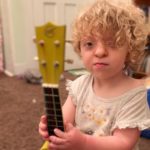Weathering the storm of Apert syndrome: João’s story

After a “perfect” pregnancy in 2017, Natalia and Igor of Brazil were excited to meet their third child. They were shocked when João was whisked away moments after delivery.
“Up until the day before he was born, everything seemed very normal,” says Natalia. “But once he arrived, we could see immediately that something was wrong: The fingers and toes on each of his hands and feet were fused together, and the shape of his head was a little different.”
It took a couple of days to get a diagnosis of Apert syndrome, a rare genetic disorder in which bones in the skull, hands, and feet fuse during fetal development.
All hands on deck to find answers
João stayed in the hospital for over a week while doctors worked to better understand how Apert syndrome impacted things such as his brain, heart, stomach, and hearing. The consensus among his care team was that he first needed surgery to relieve pressure on his brain. Because babies grow so quickly, surgery to separate fused bones in the skull (a condition called craniosynostosis) typically happens within the first six months of a baby’s life. After surgery, babies wear helmets for six to nine months to help guide and protect skull and brain growth.
“It was hard for us to process that João needed surgery right away,” says Natalia. “We had to educate ourselves about Apert and how it could impact his life, and then decide about surgery — all in a very short time.” So, together with family and friends, they launched an international search for information and treatment options.
“It wasn’t easy,” Natalia adds. “There’s a lot of old information about Apert out there. And a lot of information we didn’t know if we could trust.”
Eventually, Natalia and Igor found Dr. Mark Proctor of the Cleft and Craniofacial Center at Boston Children’s Hospital.
Dr. Proctor’s video explaining a minimally invasive treatment for craniosynostosis called endoscopic strip craniectomy (or endoscopic release surgery) was enough to prompt them to bring João to Boston Children’s.
Making a home in the unknown
Coming to Boston wasn’t an easy decision; it involved relocating their entire family.
“We felt confident in our choice, but it was still very scary,” Natalia says.
In addition to preparing João for surgery, they also needed to help João’s older brother and sister settle into life in a new country.
“It was a hurricane in the beginning,” Natalia adds. “We felt lonely having such little information about Apert. We moved to the U.S. with only a surgery date, and we hadn’t met any of the doctors in person. And we had no house, no school for the kids, and a newborn baby. We were heading to an uncertain and unknown future.”
A port in the storm
In July 2017, at 3 months old, João underwent endoscopic release surgery with Dr. Proctor.
Over the next two years, João returned to Boston Children’s frequently for regular helmet fittings and additional surgeries, including a series of syndactyly separations performed by Dr. Brian Labow and Dr. Amir Taghinia to separate all of his fingers and toes.
Away from the hospital, the family built a life in their new city.
“Now everyone is very connected to Boston,” Natalia says. “We all love the city. We made a lot of friends.”
João and his family have returned to Boston twice since their initial stay in 2019. In 2021, they stayed for a year so that Drs. Labow and Taghinia could perform a phased treatment to lengthen and straighten João’s thumbs and some of his fingers and toes. João also underwent fronto-orbital advancement (FOA) surgery, performed by Dr. Proctor and Dr. John Meara, to help reshape and reposition his forehead and orbits (the bones around his eyes).
Forging his own path
Home in Brazil, João is a confident, independent 5-year-old who loves climbing, swimming, and practicing his writing. “It’s in his personality to do things for himself,” says Igor. “We want Apert syndrome to be a detail about João, not his whole story. He’s so much more than that.”
Learn more about the Cleft and Craniofacial Center.
Related Posts :
-

Superando as dificuldades da síndrome de Apert: a história do João
Depois de uma gravidez “perfeita” em 2017, os brasileiros Natália e Igor estavam emocionados por conhecer seu terceiro filho. Eles ...
-

Sonny’s story: How an online Apert syndrome community set one family on a path to Boston
Sonny Daniel has had a busy summer. Between traveling, camp, and time with family and friends, this 4-year-old has constantly ...
-

Maisie’s story: Our journey with Apert syndrome
Our daughter Maisie is 4 years old. She loves riding her bike, baking, jumping on the trampoline, and keeping up ...
-

Minimally invasive surgery safe and effective for craniosynostosis
Traditional treatment for children with craniosynostosis — a condition in which the bones of the skull grow together too early in ...





